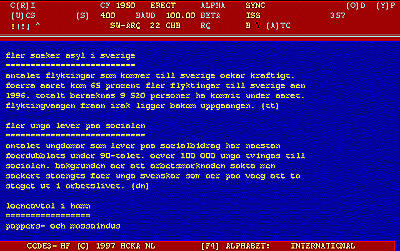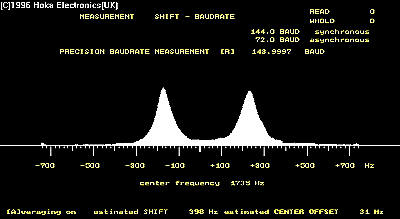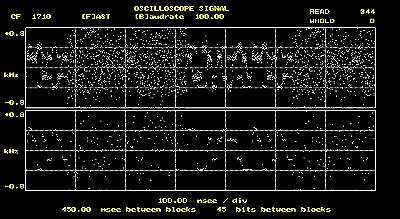Old product - Code3
Code3 version 5.0
The monitoring tool used by professionals
Software for DOS, Windows 95 and Windows 98 - last release avilable v 5.01
At the press of a key you could be decoding nearly every kind of decodeable RTTY signal there is to find on HF. Code3 is the unique software tool that provides the essential bridge between your IBM PC compatible and a communications receiver.You already have all the PC processing power you need - so why invest even more in a stand-alone unit? Code3 has more decoding systems than any other commercial decoder available. Yet these stand alone units can cost as much as 10 times as much as Code3.
What do you need to run Code3?
Any fully compatible IBM clone, running MSDOS v2.0 or later, with at least 512k free DOS memory and a spare serial port (COM's 1 to 4 supported). All IBM graphic modes up to 1024x768 (Super VGA) are supported with 16 grey scales. Code3 will work from a floppy but works best on a hard disc with as little as 1MByte free disk space.
What's in it for an HF enthusiast?
Code3 has been designed to take out all the hard work of RTTY decoding. Why spend hours pressing front panel buttons getting nowhere? At the press of a key you could be decoding nearly every kind of decodeable RTTY signal found on HF. Not merely the usual and common systems like Baudot, CW, Sitor (Amtor), ARQ-E, ARQ-E3 and FAX signals, but the other, more complex, systems that have always been there, but rarely spotted, because until Code3, no other decoder could handle them.
What extra hardware do I need?
None! Code3 version 5 comes complete with its own small professionally boxed audio-to- digital FSK convertor with built in double-insulated 230 volt PSU. All you need to provide is an audio lead from your receiver (audio level is not critical, 50mV to 2Vpp will do fine) to a phono plug. Plug in the mains, audio lead, serial lead, then install the software and you are ready to start decoding.
But I'm nervous about computers.
We know how you feel. That's why we have designed Code3 to be as automatic as possible. Pressing one key from the main menu brings up the tuning screen. Once you have correctly tuned in an RTTY signal pressing just one more key starts the powerful analysis process. Within seconds Code3 will have analysed the signal and, if recognised, begin immediate decoding. Code3 will automatically set all the right settings for you. Leaving you to concentrate on monitoring rather than fiddling! On-line help is only another key press away.
So what systems can Code3 decode?
Over 26 different systems are decodeable with the standard supplied Code3. With various additional extra options you can take this up to over 36 completely different keying systems. Compare that to hardware only decoders with their limited range of systems.
Who use all these strange systems?
Besides the usage of simple systems, such as Sitor and RTTY the Australian, Dutch, Danish, Norwegian, Spanish and Pakistani Diplomatic services also use Twinplex. The French Diplomatic also use ARQ6-70, ARQ6-90 and ARQ6-98, the Italian and Polish Diplomatic services also use POL-ARQ, the Algerian Diplomatic Corps use Coquelet and the Rumanian Diplomatic Corps use ROU-FEC and Autospec.Interested in the military action going on in the world's trouble spots? Then without Code 3, you're still missing out! The Swiss Red Cross and UN Peace keeping Forces use non-standard, modified Pactor units. Belgian UN Forces are using Coquelet13.Only one or two of the above systems are available on hardware only units - just think of all the action you are potentially missing!
But all military RTTY is encrypted
No! It is not ALL encrypted. This is the biggest misconception. If you're dedicated to monitoring these systems, then you will quickly realise some of the best catches are to be found on these 'stranger' systems. Find out what is happening in the world long before the National news service do!
So what can Code3 NOT do!?
Despite the much wider number of systems decodeable with Code3, there are obviously some systems that are designed so that even with the right decryption equipment it is undecodeable without the right "key". Also for PSK (Phase Shift) and VHF Systems you'll need our even more powerful unit, the Code30.
I don't have an expensive receiver !
OK sure, serious Utility monitoring does require you to use a high grade commercial receiver, but Code3 has a fully automatic hardware audio filter for those without expensive fully adjustable IF filters.If, for example, you're stuck with just a 3kHz wide SSB filter shipped with your receiver - no problem. Code3 uses its own fully adjustable automatic filter so that it 'sits' around the RTTY signal eliminating any adjacent frequency interference!This is all done without any need for you to think about what the best bandwidth should be. Widen the shift or increase the baud speed and the filter widens too. Decrease the shift and/or baud speed and the
But I don't know an ARQ-E3 from an SITOR-A!
Let Code3 do the hard part of Utility monitoring and increase your productivity. Why waste hours trying to figure out why something isn't printing when Code3 can analyse the system and tell you what system it is and if it will ever print. If Code3 can not classify the system, tune on!
What about after sales service?
Anytime up to 1 year after purchase you can request a free update to the latest version of the software. After that it is a mere £25 per request! The Guarantee lasts a full year too, and this applies to both the disc becoming damaged or the hardware failing in some way.If you are still not happy that after 30 days of use you have not bought the most comprehensive decoder on the market today, contact us and ask for your money back. If, at a later stage, you want to upgrade to our Code30 product we can even give you a very attractive upgrade offer that means your money has been well invested. Our lifetime support does not just stop at Code3. If you want advice about any aspect of Utility Monitoring - then ask us. HOKA has decades of Professional Radio Monitoring experience between us.
What does a decode screen look like?

The top part of the screen is showing the full status of the decoding
system. The decoded text can be not only sent to the screen but also to
the printer and/or hard disk if required. On-line help giving a short
description of each system, and the commands to use, is available at all
times by pressing the ? key.On entry to each decoding module, Code3
automatically sets the Baud speed, Shift, Interleave and the number of
channels to their most commonly found defaults so that in the majority
of cases it will print almost immediately. Most modules will even
automatically determine Normal/Reverse. E.g. Baudot automatically locks
into the incoming systems' baud speed and polarity on entry to the
module and SITOR will automatically switch to Modes A and B as
appropriate (even if the station switches mode mid-traffic).
So what comes as extra options?
For the experienced monitors amongst you there is Piccolo Mk6,
Coquelet Mk1 and Coquelet Mk2, ROU-FEC, HC-ARQ, HNG-FEC and TORG-10/11.
The SYNOP AAXX/BBXX weather decoder for Baudot is optionally available
too. For those with a maritime interest there is GMDSS. (This is the new
100 baud system that means that by 1999 all sea going vessels must be
equipped with GMDSS equipment instead of a Radio Officer using Morse on
500kHz.) What ever your views on this - its coming and you'll miss all
the HF maritime distress traffic without the GMDSS option!
Systems decoded:
ARQ1000 Duplex (aka ARQ-E), ARQ-E3, ARQ-N, ARQ1000 Simplex (ARQ-S),
ARQ6-70, ARQ6-90&98, ARQ-SWE/ SWED-ARQ, ARTRAC Mk1 & Mk2, ASCII,
Autospec Mk1 & Mk2 (aka Spread 11/21/51), Baudot, Facsimile, FEC-A/
FEC100/ FEC101/ FEC100A, FEC1000 Simplex (FEC-S), Hellscreiber, Morse,
Packet (at 300 Baud), PACTORs 1, 2 & 3 (Amateur, ICRC and UNHCR modes),
POL-ARQ, SITOR ARQ/ FEC (i.e. CCIR 476/625 Modes A&B), Twinplex (CCIR
476 Variant), CCIR 242 and CCIR 342-2.
Analysis Tools:

Frequency spectrum ('amplitude'
against frequency)

Frequency 'scope (frequency against time)
Options:
Special Systems - This module consists of additional decoders for
Racal's Piccolo Mk6, Coquelet 8 & 13 (i.e. Mk's 1 & 2), TORG-10/11,
ROU-FEC, HNG-FEC and HC-ARQ.
SYNOP - Decode all those cryptic 5 figure AAXX and BBXX groups sent by
Meteo Stations. Saves all decoded data to disk in an industry standard
format. ALL known WMO stations decoded, not just Europe!
GMDSS - Full implementation of this new Maritime system according to
CCIR Reports 493-5 and 541-2.
Download Code3 data sheet